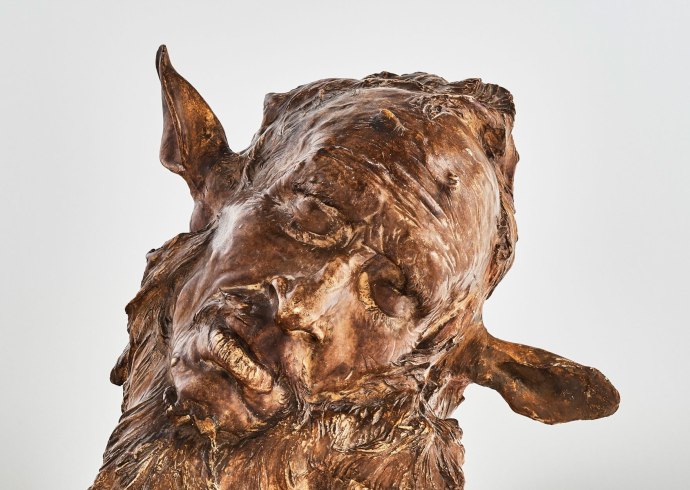
Inventory Number: ZS122
Size: 20.75h x 7.50w in
Material: Glazed Earthenware
Year Made: c. 1895
Status: Available
The use of floral motifs, in particular tulip flowers, are highly refined and explored in Zsolnay's earthenware pottery. Three tulips undulate from an elegant base with accents that include curved stems and roots. The flowers come into bloom with the exquisite use of iridescent luster glazes in a spectrum of colors. Enjoyed as a work of sculpture in the round, Zsolnay's "Triple Tulip Vase" is a dynamic example of the artist's mastery.
----------
In 1853, an industrious family of storekeepers named Zsolnay established a ceramics factory in their sleepy hometown, Pécs, in southwestern Hungary.[i] Within a few decades, their facilities sprawled across acres and employed hundreds of people. By the turn of the century, at the height of the company’s success, it sold wares in distributor showrooms and world’s fair booths from Sydney to Istanbul to Chicago. Some products were as humble as pillboxes and roof tiles, while the most sought after Zsolnay vessels—both then and now—were made with iridescent glazes and sinuous forms like the one shown here.
The Zsolnays collaborated with chemists to perfect glaze formulas composed of specialized ingredients like titanium, vanadium, and molybdenum. They named these iridescent mixtures eosin, in homage to Eos, the Greek goddess of dawn. They were partly inspired by medieval Middle Eastern and Italian Renaissance ceramists’ achievements with metal oxides and metallic sheens. The Zsolnays developed matte, translucent, opaque, crackled, and crystalline variations, each which required numerous firings. Surfaces were textured with sand, dotted to look like hammered metal, and streaked in emulation of a feldspar called labradorite. The manufacturing teams came up with proprietary clay recipes as well: their porcelain-faience was porous and hence glaze-friendly, and their Pyrogranite stoneware proved ideal for fireproof, weatherproof architectural ornament.
Thousands of different forms and motifs are recorded in the Zsolnays’ catalogs and sketchbooks. The designs, in keeping with late Belle Epoque tastes, often represented dream states, evanescence, and ephemerality. Smoke, tree roots, twilit hills, and sea foam undulated on vessels sliced and punctured to the point of seeming instability, or wrapped in tendrils of precious metal filigree. The clay was sculpted with figures of cavorting nymphs and fauns—some of which were engineered to hold light bulbs—and entangled in dragons and snakes. The latest aesthetic fashions from America and Western Europe were imported as the design teams traveled overseas: checkerboards and stripes from Glasgow, Darmstadt, and Vienna, and ripples resembling Louis Comfort Tiffany’s experiments in glass. Foreign artists, architects, and designers, as prominent as Britain’s Walter Crane, Austria’s Joseph Maria Olbrich, and Germany’s Hans Christiansen, came to Pécs and contributed ideas.
A patriotic streak coursed through the Zsolnay repertoire, too, reflecting Hungary’s post-1860s phase of relative independence from Austrian imperial control. The firm decorated vases and chargers patterned with tulips based on floral folk embroidery and with mythical birds of prey mentioned in Hungarian legends. Bowls and tiles came with bulls’ heads based on tenth-century vessels excavated in Hungarian archaeological digs. Stoppered disk-shaped bottles were modeled after traditional flasks carried by the country’s shepherds.
Generations of the founding family kept the business afloat through World War I privations and postwar national trauma. Although the Treaty of Trianon secured the peace in 1920, the newly independent Hungary was less than one third of the former empire and the factory lost access to quarries and mines that provided key components for their clay and glazes. In the 1920s and 1930s, they attracted some market attention again with functional objects like electrical insulators as well as Art Deco exotica based on objects found in Egyptian tombs.
World War II, however, devastated the firm and decimated the workforce. Looters descended on the factory grounds. The Communists jailed and tortured the remaining Zsolnay family members and drove them into exile. Under nationalized rule, the company limped along. The Eosin glazes were revived in a garish shade of green and applied to busts of Lenin and statuettes of Elvis. A handful of famous Hungarian émigrés, including ceramist Eva Zeisel and Op-Art painter Victor Vasarely--himself a Pécs native--were eventually allowed to contribute designs.
The twenty-first century has witnessed an improbable revival of interest in circa-1900 Zsolnay designs. They have been exhibited widely outside of Hungary—a major survey was held in 2002 at the Bard Graduate Center in Manhattan–and at least a dozen books have highlighted the firm’s contributions. The company, which has remained in business under various owners, offers reproductions of its Art Nouveau wares and much of the original grounds have been transformed into a popular cultural center. The star attraction is a museum packed with hundreds of antique Zsolnay pieces assembled by László Gyugyi, a Hungarian émigré in the U.S., who started collecting in the 1960s. Where eosin was popularized and Pyrogranite invented, where powders and pigments were brought in from quarries and mines at the edges of a dying empire, and where the founding family lived alongside their workers and apprentices, shelves are now laden again with a dreamscape of nymphs, fauns, dragons and snakes.
[i] There are numerous useful histories of the firm. See, for instance, Éva Csenkey and Agota Steinert, eds., Hungarian Ceramics from the Zsolnay Manufactory, 1853-2001 (New Haven and London: Bard Graduate Center and Yale University Press, 2002) and Éva Csenkey, László Gyugyi, Éva Hárs, The Golden Age of Zsolnay : the Gyugyi Collection Returns to Pécs (Pécs: Zsolnay Heritage Trust, 2010).